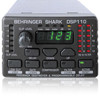Behringer SHARK DSP110 Manual - Page 6
Control elements
 |
View all Behringer SHARK DSP110 manuals
Add to My Manuals
Save this manual to your list of manuals |
Page 6 highlights
SHARK DSP110 1.3 Control elements Fig. 1.2: Front panel control elements of the DSP110 1 2 + 3 The CLIP LEVEL METER shows you whether or not the digital circuitry is driven correctly. Any corrections can be made with the CLIP LEVEL control . Be sure that the CLIP LED won’t light up. The CLIP LEVEL control lets you adapt the internal gain optimally to the digital circuitry. If gain is too high (CLIP LED lights up), raise the CLIP LEVEL value by turning the control to the right (and vice versa). Thus, you can shift the operating level upwards/downwards. The CLIP LEVEL control does not affect the input/output levels, but adapts the audio signal as optimally as possible to the threshold of the digital circuitry. These five LEDs symbolize the units of the parameters that can be adjusted on the display . 6 1. INTRODUCTION















